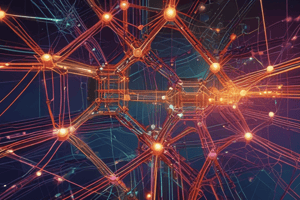Podcast
Questions and Answers
What is the primary purpose of overhead in digital signaling?
What is the primary purpose of overhead in digital signaling?
- To ensure proper signal routing and interpretation (correct)
- To reduce noise interference in the signal
- To convert analog signals to digital signals
- To increase the strength of the digital signal
What is the main advantage of digital signals over analog signals?
What is the main advantage of digital signals over analog signals?
- Digital signals are more resistant to noise interference (correct)
- Digital signals are less reliable than analog signals
- Digital signals are more prone to noise interference
- Digital signals require more pulses to transmit the same information
What is the primary cause of EMI (Electromagnetic Interference)?
What is the primary cause of EMI (Electromagnetic Interference)?
- Radio waves from broadcasting stations
- EMI waves emanating from electrical devices or cables (correct)
- Severe thunderstorms
- Crosstalk between wires in a cable
What is the term for the loss of a signal's strength as it travels away from its source?
What is the term for the loss of a signal's strength as it travels away from its source?
What is the primary purpose of an amplifier in analog signaling?
What is the primary purpose of an amplifier in analog signaling?
What is the term for the delay in data transmission between the sender and receiver?
What is the term for the delay in data transmission between the sender and receiver?
What is the primary difference between digital and analog signals?
What is the primary difference between digital and analog signals?
What is the term for the undesirable influence that degrades or distorts a signal?
What is the term for the undesirable influence that degrades or distorts a signal?
What is the primary difference between analog and digital signals?
What is the primary difference between analog and digital signals?
What is the unit of measurement for frequency?
What is the unit of measurement for frequency?
What is the benefit of analog signals over digital signals?
What is the benefit of analog signals over digital signals?
What is the purpose of an antenna in wireless communication?
What is the purpose of an antenna in wireless communication?
What is the relationship between frequency and wavelength?
What is the relationship between frequency and wavelength?
What is the main drawback of analog signals?
What is the main drawback of analog signals?
What type of cables carry data signals in the form of light?
What type of cables carry data signals in the form of light?
What is the term for the strength of an analog or digital signal?
What is the term for the strength of an analog or digital signal?
Flashcards are hidden until you start studying
Study Notes
Computer Network Media
- Twisted-pair (TP) cable and Coaxial cable use metallic (copper) conductors to receive and transmit signals in the form of electrical current.
- Fiber-optic cables carry data signals in the form of light, which is propagated along the inner core by reflection.
Wireless Communication
- Wireless communication employs an antenna for transmission and reception of signals through air, vacuum, or water.
- The antenna radiates electromagnetic waves from the surrounding medium for transmission.
- The antenna picks up electromagnetic waves from the surrounding medium for reception.
Analog and Digital Signaling
- Information can be transmitted via one of two signaling methods: analog or digital.
- The strength of an analog or digital signal is measured by its voltage.
- Analog signal examples include speech, sirens, and live music.
- Analog data signals have voltage that varies continuously, with properties including amplitude, frequency, wavelength, and phase.
Analog Signal Characteristics
- Amplitude refers to the strength of an analog wave.
- Frequency refers to the number of times amplitude cycles over a fixed time period, measured in hertz (Hz).
- Wavelength refers to the distance between corresponding wave cycle points, which is inversely proportional to frequency and expressed in meters or feet.
Analog Signal Benefits and Drawbacks
- Analog signals have the benefit of being more variable.
- However, they are susceptible to transmission flaws, such as noise.
Digital Signaling
- Digital signal pulses consist of pulses of voltages, where positive voltage represents a 1 and zero voltage represents a 0.
- Digital signals use a binary system, where 1s and 0s represent information, and each bit (binary digit) has a possible value of 1 or 0.
Digital Signal Benefits and Drawbacks
- Digital signals have the benefit of being more reliable and less susceptible to noise interference.
- However, they require many pulses to transmit the same information, and have an overhead of non-data information, such as addressing information.
Transmission Flaws Affecting Data Signals
- Noise refers to any undesirable influence that degrades or distorts a signal.
- Common transmission flaws affecting data signals include signal noise, attenuation, and latency.
Sources of Interference on Data Signals
- Electromagnetic interference (EMI) is caused by EMI waves that emanate from electrical devices or cables carrying electricity.
- Radiofrequency interference (RFI) is caused by radio waves.
- Severe thunderstorms can also cause interference.
Crosstalk and Attenuation
- Crosstalk occurs when a signal traveling on one wire or cable infringes on the signal traveling over an adjacent wire or cable.
- Attenuation refers to the loss of a signal's strength as it travels away from its source.
- Amplifiers can be used to strengthen analog signals, but they also amplify noise.
Studying That Suits You
Use AI to generate personalized quizzes and flashcards to suit your learning preferences.




